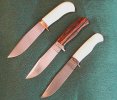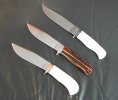- Joined
- Jan 21, 2000
- Messages
- 8,888
Some time ago I decided to pull together all the elements I appreciate in a full-size hunter. I listed the aspects of each part of the knife that are important to me after fifty years of field dressing and butchering hundreds of animals from javelina up to elk size. Once I completed the list and managed a sketch, I realized I'd never owned a knife that incorporated all these features, so I decided to ask a few of the top makers in the country if they would consider building it for me. Below is a copy of my sketch and photos of resulting pieces from three master smiths.
I thought the design might serve as a basis for interesting discussion here, so I'm offering it for your consideration and certainly all views are welcome.
Thoughts on Size:
I typically carry a 3-4" blade folder for small game and utility purposes, but a 5-6" fixed blade hunter is my preferred knife around camp and on large game. I'm a native Texan and still hunt there often, and Texas once had a legal limit of 5.5" blade length for belt-carry knives. I find this length serves me well. That and my other size/use preferences have resulted in the following dimensions:
Overall Length: 10 inches
Blade Length: 5 ½ inches from guard face to point
Handle: 4 ½ inches, including guard
Blade Thickness: 3/16" at ricasso with distal taper to point
Sketch:

NOTE: Edge starts away from the ricasso at a DOWNWARD angle from centerline to a deep belly. Top of spine is clean and straight out to a swedged clip (straight clip, not dished), the clip running half the length of the blade.
Thoughts on Design:
1. The way the edge line starts from the face of the guard at a downward angle does two things: a) it helps hold material on the edge in a pull-cut much like a recurve does but keeps the edge in line for straightforward sharpening; and b) it develops a deep belly, well-positioned for skinning. The straight ricasso, in-line with the edge (no choil), allows the blade to slide all the way in and be drawn back out without snagging. There is enough ricasso behind the edge to support a finger when choking up on the blade.
2. The clip also does two things: a) the combination of the length of the clip, starting about midway between hilt and point, together with the clip angle, forms a fine working point positioned well for penetration. On a larger hunting blade like this, I appreciate a fine
point when working around joints and in tight places; and b) the clip is straight rather than dished, so it can be laid flat against a hide to precisely guide the start of a skinning cut.
3. Neither the spine nor the top of the handle rises above the top line of the knife. This is primarily a cosmetic thing with me, but is also a positioning function. I prefer knives that don't "break back" at an angle between spine and handle, with neither the line of the spine nor the top line of the handle rising up from level. I appreciate a design with the top line of the handle in line with the spine, then dropping away at the butt.
4. The contours of the handle achieve several things: a) the rounded butt is comfortable when tucked into the center of the palm, so that the index finger can be laid along the top of the handle for controlled point-work/penetration as when taking out back straps; b) the rounded butt is also comfortable to strike with the palm, to start the point into resistant materials; c) the contouring along the bottom of the handle allows good control, security and comfort in all positions, including pull-cuts with the handle upside down; and d) the "bird's beak" at the butt gives something to pull against to free the knife if the blade binds in something.
5. Finally, I really appreciate a radiused spine and also a radiused underside to the ricasso, for comfort when choking up on the blade.
Here are pics of finished knives made from the sketch and list of features:

The damascus knife is by Bailey Bradshaw in elephant ivory and his 400-layer 01-15n20 ladder damascus with an amazing French greyed, deep-relief engraved guard -- pure elegance. The amber-stag handled knife is by Rick Dunkerley in forged CPM10V (heat treated to Rc 64 by Phil Wilson) and is a meat-and-hide razor with a super-thin edge, whisper-fine point, and edge holding that should probably be measured in generations. The one with the bronze guard is by Jason Knight in elephant ivory and forged L6. I really like its robust lines and the way it fills the hand. None of the three has tang surfaces exposed to the hand, which can be a comfort issue when the temperature drops. The Bradshaw is a take-down with recessed finial; the Dunkerley has a mortised tang, epoxied and pinned; and the Knight handle is one piece of ivory with Jason's trademark "barbed tang" construction. All tangs are reduced but sturdy--no stick tangs here.
Bailey ran a thread almost a year ago on the one he did for me. His pics are much better than mine--especially those showing the detail on his engraving. Here's that link:
http://www.bladeforums.com/forums/showthread.php?t=618415
Thanks in advance for your thoughts. I hope you enjoy the pics as much as I do.
Will
I thought the design might serve as a basis for interesting discussion here, so I'm offering it for your consideration and certainly all views are welcome.
Thoughts on Size:
I typically carry a 3-4" blade folder for small game and utility purposes, but a 5-6" fixed blade hunter is my preferred knife around camp and on large game. I'm a native Texan and still hunt there often, and Texas once had a legal limit of 5.5" blade length for belt-carry knives. I find this length serves me well. That and my other size/use preferences have resulted in the following dimensions:
Overall Length: 10 inches
Blade Length: 5 ½ inches from guard face to point
Handle: 4 ½ inches, including guard
Blade Thickness: 3/16" at ricasso with distal taper to point
Sketch:

NOTE: Edge starts away from the ricasso at a DOWNWARD angle from centerline to a deep belly. Top of spine is clean and straight out to a swedged clip (straight clip, not dished), the clip running half the length of the blade.
Thoughts on Design:
1. The way the edge line starts from the face of the guard at a downward angle does two things: a) it helps hold material on the edge in a pull-cut much like a recurve does but keeps the edge in line for straightforward sharpening; and b) it develops a deep belly, well-positioned for skinning. The straight ricasso, in-line with the edge (no choil), allows the blade to slide all the way in and be drawn back out without snagging. There is enough ricasso behind the edge to support a finger when choking up on the blade.
2. The clip also does two things: a) the combination of the length of the clip, starting about midway between hilt and point, together with the clip angle, forms a fine working point positioned well for penetration. On a larger hunting blade like this, I appreciate a fine
point when working around joints and in tight places; and b) the clip is straight rather than dished, so it can be laid flat against a hide to precisely guide the start of a skinning cut.
3. Neither the spine nor the top of the handle rises above the top line of the knife. This is primarily a cosmetic thing with me, but is also a positioning function. I prefer knives that don't "break back" at an angle between spine and handle, with neither the line of the spine nor the top line of the handle rising up from level. I appreciate a design with the top line of the handle in line with the spine, then dropping away at the butt.
4. The contours of the handle achieve several things: a) the rounded butt is comfortable when tucked into the center of the palm, so that the index finger can be laid along the top of the handle for controlled point-work/penetration as when taking out back straps; b) the rounded butt is also comfortable to strike with the palm, to start the point into resistant materials; c) the contouring along the bottom of the handle allows good control, security and comfort in all positions, including pull-cuts with the handle upside down; and d) the "bird's beak" at the butt gives something to pull against to free the knife if the blade binds in something.
5. Finally, I really appreciate a radiused spine and also a radiused underside to the ricasso, for comfort when choking up on the blade.
Here are pics of finished knives made from the sketch and list of features:


The damascus knife is by Bailey Bradshaw in elephant ivory and his 400-layer 01-15n20 ladder damascus with an amazing French greyed, deep-relief engraved guard -- pure elegance. The amber-stag handled knife is by Rick Dunkerley in forged CPM10V (heat treated to Rc 64 by Phil Wilson) and is a meat-and-hide razor with a super-thin edge, whisper-fine point, and edge holding that should probably be measured in generations. The one with the bronze guard is by Jason Knight in elephant ivory and forged L6. I really like its robust lines and the way it fills the hand. None of the three has tang surfaces exposed to the hand, which can be a comfort issue when the temperature drops. The Bradshaw is a take-down with recessed finial; the Dunkerley has a mortised tang, epoxied and pinned; and the Knight handle is one piece of ivory with Jason's trademark "barbed tang" construction. All tangs are reduced but sturdy--no stick tangs here.
Bailey ran a thread almost a year ago on the one he did for me. His pics are much better than mine--especially those showing the detail on his engraving. Here's that link:
http://www.bladeforums.com/forums/showthread.php?t=618415
Thanks in advance for your thoughts. I hope you enjoy the pics as much as I do.
Will
Last edited:
